Bernd Minkler
CRN Management GmbH
Bonn, Germany
[email protected]
Wolfgang Süß
SENSYS GmbH
Bad Saarow,Germany
[email protected]
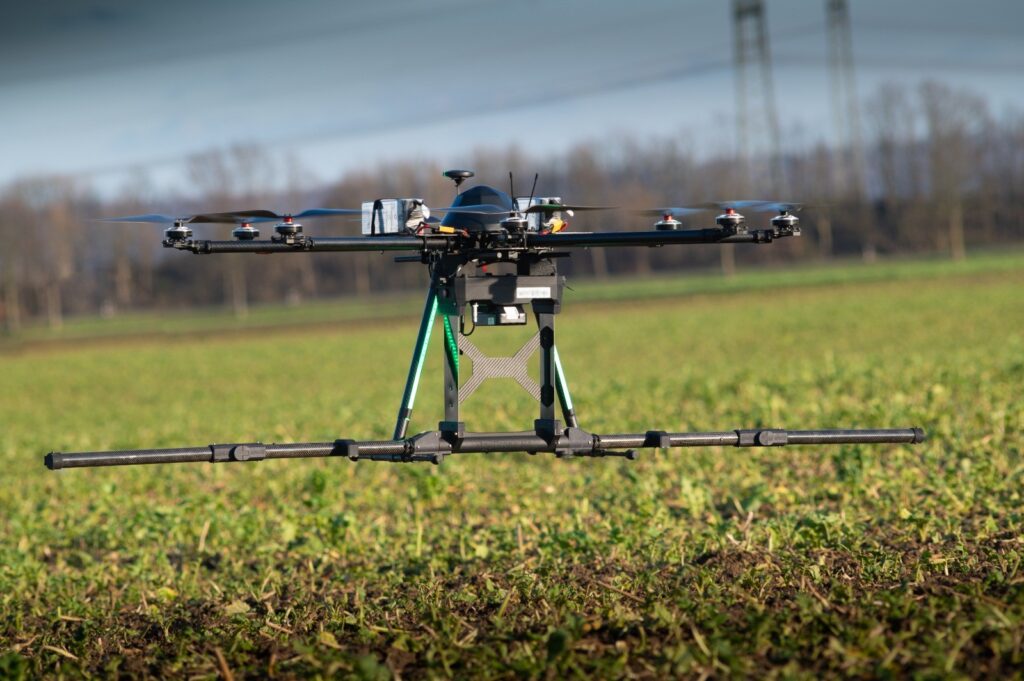
Introduction
Commercial drone applications have grown exponentially. Unmanned aerial vehicles (UAV) outfitted with special sensors can detect anomalous situations quickly. The need to operate UAV for unexploded ordnance (UXO) detection and mapping has seen an exciting increase over the past 10 to 15 years. UAV-based UXO detection speeds up the detection process and reduces the associated costs. The use of UAV fitted with specialized sensor payloads offers decisive advantages over conventional methodologies including the elimination of the need for on-the-ground field personnel and the associated safety risks. In this article Bernd Minkler and Wolfgang Süß look at how UAV can be equipped with advanced sensor technology to support detection, identification, and mapping of a particularly wide range of unexploded ordnance objects.
Detecting the Threat
Unexploded and abandoned explosive ordnances (UXO, AXO), common to post-conflict situations and peace-keeping deployments, require new methodologies for detection, identification, and removal. The threat of a broad range of different UXO and AXO, including Improvised Explosive Devices (IED), persists where civilians are targeted during time of conflict – especially in transit systems and prime urban locations. IED are now responsible for 80% of civilian casualties in conflicts. Their detection and disposal is executed by highly trained Explosives Ordnance Disposal (EOD) squads, first responders, and security staff. The variety of IED mechanisms, homemade explosives (HME), and deployment methods is a constant challenge for responders who must detect the wide variety of buried IED and other explosives and neutralise them before they detonate. The biggest challenge is to reduce the time it takes to find, identify, and eliminate them. UAV carrying suitable sensor payloads offer the ability to explore complex terrain and hidden threats at an accelerated pace while eliminating safety risks to field personnel caused by traditional on-the-ground detection methods.

Drones Are a Major Option
Industry has developed various concepts for equipping all types of UAV (e.g., rotary-wing, fixed-wing, etc.) for rapid UXO, AXO or IED detection. However, some of them are extremely difficult to detect due to a very low or no metal content. Consequently, new sensors or combinations of sensors (multisensors) will be of paramount importance in recognizing and identifying items with very low or no metal content in difficult terrain with a high detection probability and even more importantly a low false alarm rate. This multisensor capability, coupled with the advantages of a drone system, can offer a decisive advantage in the detection and removal of explosives. Activities such as humanitarian mine clearances (i.e., demining) can benefit from the use of UAV’s equipped with multisensors to safely disrupt difficult-to-access IED, military ordnance, landmines, and other incendiary devices.
Until recently, EOD teams active in many countries utilized conventional ground detection methods and equipment to enable them to do the dangerous tasks of detecting and identifying UXO, AXO, and IEDs. Conventional ground detection methods include the use of search dogs and handheld detectors and diagnostic systems – magnetic or primarily electromagnetic. This equipment is designed to spot person-borne (suicide) and buried IED, as well as activity associated with IED emplacement (e.g., camouflaging); some equipment is capable of analysing for the IED and, also, its provenance – as part of weapon intelligence. Robotics – Unmanned Ground Vehicles (UGVs), also known as remotely operated vehicles (ROVs), and even UAV – were invented in the 2000s and are now used to find explosives.
UAV fitted with specialized sensor payloads are changing the operational profile of specialized search teams or individuals looking for UXO. Inexpensive and easy to operate, UAV represent a mature technology. When fitted with sophisticated sensors, they can detect and identify hidden objects without risk to personnel on the ground. They can identify both surface and near-surface threats even in extremely difficult terrain.
CRN Management GmbH, developing and offering special services with partners under the trademark “airspector“ for drone applications in the civilian market (Figure 2), identifies three main trends:
Firstly, UAV offer a wide range of operational advantages over ground-based systems.
Secondly, UAV complement, or replace, ground-based applications, especially in difficult and inaccessible terrain.
Thirdly, the combination of UAV and existing or newly developed, highly specialized measurement sensors is considered to be readily available, cost-effective, and a safer alternative.
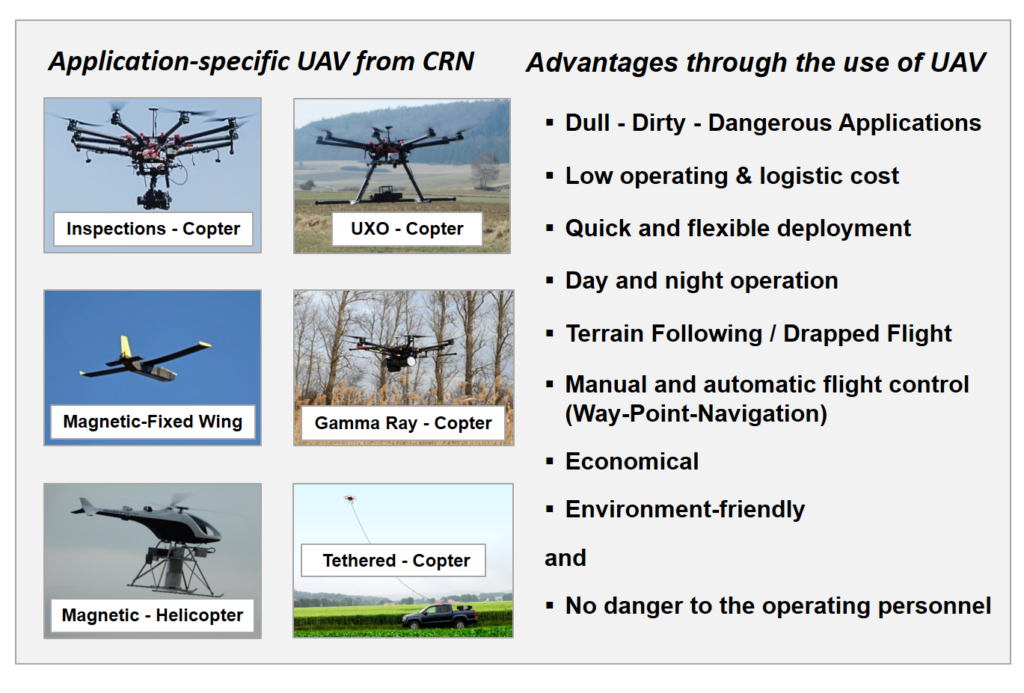
UAV fitted with specialized measurement sensors can be employed over urban terrain and especially large areas that are considered to be extremely difficult to access in terms of surface conditions, with all forms of terrain, soil structures and wet or water areas becoming the target of airborne UXO detection. As the variety of undetonated explosives can be found in various locations on the surface, near the surface, and at greater depths (undetonated bombs), the use of UAV can offer a major advantage over existing methodologies, by reducing the time to detect them, eliminating safety risks to personnel, and minimizing costs.
From Theory to Practice
The theoretical approach for rapidly detecting and identifying UXO and other explosives ranges from ground-/vehicle-based geophysical processes (magnetics, electromagnetics with metal detectors, GPR, DC geoelectrics, passive microwave technology) to optical processes (infrared, ultraviolet, multi-/hyperspectral). Acoustic and seismic, as well as laboratory methodologies, such as mass spectrometry and gas chromatography, also form part of the scheme. Some of them represent tried-and-tested methodologies, including: magnetics (MAG); electromagnetics (EM); ground penetrating radar (GPR) or synthetic aperture radar (GPR-SAR) and optical processes (OPT). The capabilities of these methods vary – more or less – depending on UXO characteristics (including caliber, material, depth, and environment/soil structures) and this impacts detection performance, meaning that individual geophysical sensors for UXO exploration in civilian operational scenarios are only partially effective (Table 1).
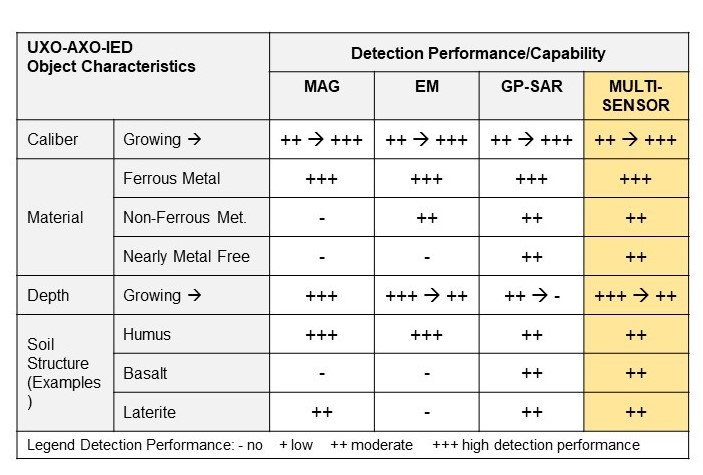
To be clear, only a multisensor system – with the ability to bring together individual sensor data – can result in the robust and secure detection and identification of a broad range of UXO, AXO, and IED laid in difficult terrain. The primary goal in the development and utilization of a multisensor system, particularly with intelligent and effective data fusion, is to increase the detection probability and reduce the false alarm rate, both of which will increase the classification quality.
This type of multisensor system – combined with an UAV‘s operational advantage – can offer significant advantages over conventional methodologies currently used for UXO detection and exploration. A drone-based multisensor system is believed to be the only alternative for EOD missions undertaken in difficult terrain and can be used to complement or replace ground-based detection systems.
The technical concept of a UAV-based reconnaissance system – UXO-Copter – developed by CRN with their partners TVN and SENSYS is now available for UXO detection, identification, and mapping. Developed on the basis of a multicopter system from Hannover, Germany-based TVN Connect GmbH, and fitted with a magnetic sensor array – MagDrone R4 – from SENSYS GmbH in Bad Saarow (State of Brandenburg), it is capable of supporting both civilian and military EOD/counter-IED systems (Fig. 3).
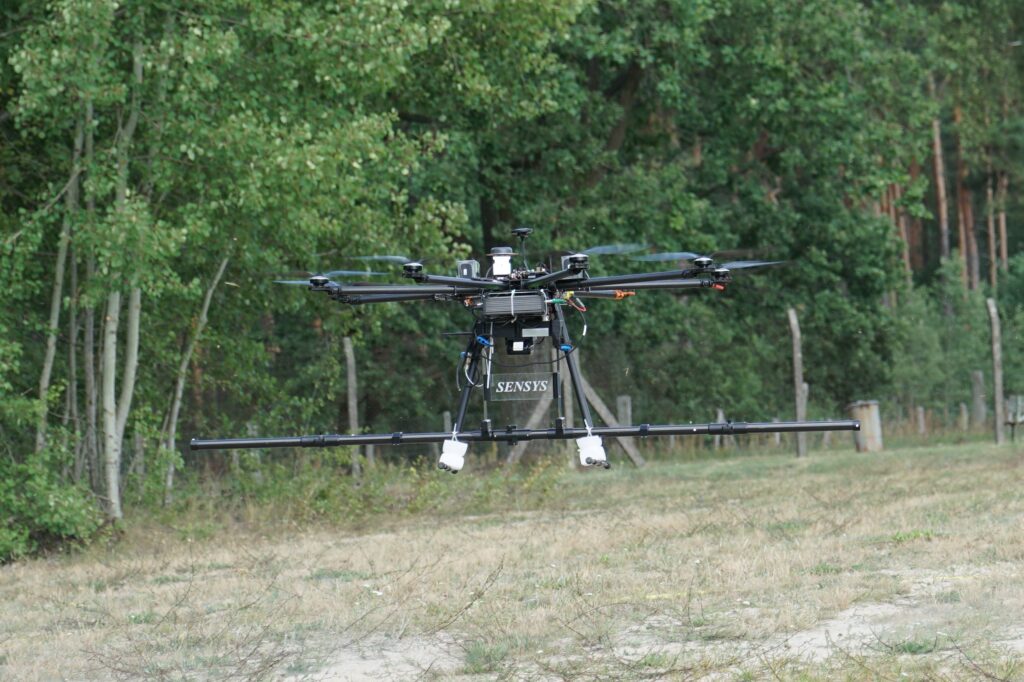
The multicopter, which is operated manually or automatically, can be employed at low altitude, utilizing high-precision GPS waypoint navigation for rapid obstacle detection. Geophysical measurements used for the detection or localization of ferromagnetic objects are undertaken by magnetic sensors. Equipped with five three-axis Fluxgate sensors with high sampling rates and sensitivity, the magnetic sensors (MagDrone R3 and R4) do not only possess data storage for offline evaluation but also offer online data transmission for fast evaluation of measurements in virtually real time.
With the potential of a flown electromagnetic detector, SENSYS is currently investigating the possibility of bringing its land version into air to fit to the CRN UAV portfolio. With a time domain electromagnetic (TDEM) detector not only ferrous objects, but all conductive materials (even those with small metal content) can be detected, widening the range of items to be found and cleared.
Various research and funding projects (e.g., ODYSSEY 2025 in Chad) and civilian organizations are currently evaluating the use of commercial UAV fitted with thermal and hyperspectral cameras for the detection of landmines. These efforts are aimed to accelerate land clearance for the local population by increasing the efficiency achieved through the combined use of UAV, evidence-based aerial detection techniques, and mobile data collection interfaces.
By adding optical sensors to the UXO-Copter reconnaissance system, imagery of the terrain or ground structure can be used for ”change detection” procedures, identifying objects near the surface (e.g., anti-personnel mines or IED). The imagery enables responders to react quickly to difficult situations. By utilizing this methodology, it is possible to reduce the threat (often with a high iron metal content) by pre-exploration of marshes and roads.
In partnership with other companies, CRN is involved with evaluating the potential applications of a civilian UAV-based UXO detection multisensor system. A multisensor system fitted to two UAV platforms from U-ROB GmbH in Bielefeld (State of North-Rhine Westphalia) consists of various sensor payloads (Figure 4), including: a magnetic sensor; an electromagnetic system (both provided by SENSYS); a GP-SAR derived from the Institute of Radio Frequency Technology and Radar Systems of the German Aerospace Center (DLR) in Oberpfaffenhofen (Bavaria); and optical sensors developed by IGI mbH headquartered in Kreuztal (State of North-Rhine Westphalia). Effective UXO detection, identification, and exploration is supported by downstream sensor data fusion methodologies – superimposing the signal/data of the different sensors and application of neuronal net algorithms (from Ingenieurbüro RS&T GmbH based in Clausthal-Zellerfeld, State of Lower Saxony). A high-precision position system (also from IGI) ensures data correlation between the two UAV Sensor systems.
Only this approach provides a significant increase in detection probability and, in particular, a reduction in false alarm rates for the identification of real targets in the wide range of UXO-AXO-IED.
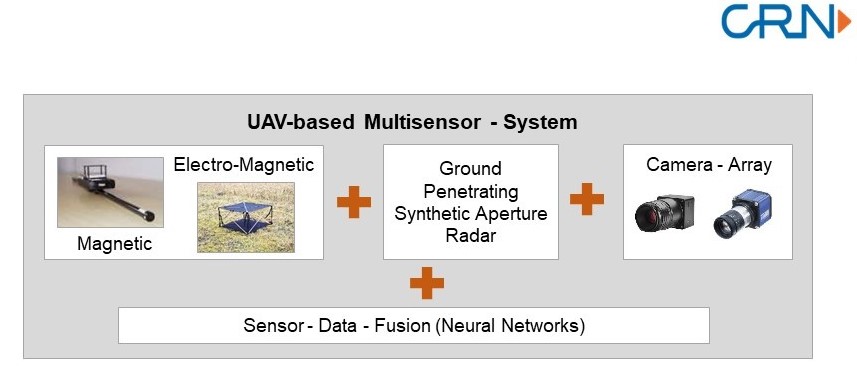
Discussion

Time is critical for the detection and identification of UXO, AXO, and IED. IEDs – the plural used deliberately here as many actions involve multiple devices – represent an extra threat to civilian populations. For decades, the IED had been the weapon of choice for terrorists and insurgents. The number of civilian casualties from IEDs, excluding car bombs and suicide attacks, has increased by more than 72% from 2011 to 2020, according to UK-based charity Action on Armed Violence (AOAV), when more than 58,000 civilians were killed or injured by IEDs. 2020, the year that saw the global COVID-19 pandemic shaking entire countries and societies, was another example of how IED incidents were increasing in a number of countries, including Afghanistan with more IED casualties than in the previous twelve months. Iraq alone accounted for 44% of those casualties. Five countries suffered most: Afghanistan, Iraq, Colombia, Pakistan, and Somalia. These examples show the urgent need for improved counter-UXO/counter-IED actions. From the authors‘ point of view, the complexity of detection of the threats (differing UXO-
IED configurations) with low false alarm rates and the associated challenges in the rapid discovery and identification of explosives in difficult environments (urban spaces and a wide range of land areas) can only be met by a drone-based multisensor system configured from geophysical (magnetics, electromagnetics, GP-SAR) and optical sensors. In doing so, CRN continues to work with partners to develop a mission-oriented system to cope with new threats.
When deployed in combination with unmanned platforms – be they multicopters, fixed-wing or helicopter drones – a multisensor system can offer an inherent advantage over existing, traditional methodologies that were always faced with enormous risks. A UAV-based magnetic sensor system designed and developed by CRN – and supplemented by optical sensors – can effectively support civilian UXO detection and humanitarian demining in difficult environments. It is a constant challenge for responders – who must detect buried explosives and neutralise them before they detonate.
Conclusion
UAV technology is not new; but it is a technology that drives commercial (and military) industry applications forward, offering authorities and other non-military organizations new opportunities for improved safety and security. Aerial detection of UXO and buried explosives by employing ultra-fast UAV-based multisensor systems will likely play an enormous role in the 2020s.
Author Bios

Bernd Minkler
CRN Management GmbH
Bonn, Germany
[email protected]
Bernd Minkler holds a graduate engineering degree from the University of Kassel, Germany. He is Managing Partner of CRN Management GmbH headquartered in Bonn, Germany, an independent consultancy and service provider. CRN offers technical capabilities and subject-matter proficiency to help clients in energy, mining, agriculture, forestry, industry, and governmental organisations to plan new applications and new uses for drones. This is embedded in overall business development activities, professional project management capabilities, and promoting networking between people and individual companies and organizations.
Wolfgang Süß
ENSYS GmbH
Bad Saarow,Germany
[email protected]
Wolfgang Süß is Managing Director of SENSYS GmbH in Bad Saarow, Germany, specializing in search and detection devices for ammunitions with ferrous or conductive content, as well as monitoring and tracking underground infrastructures, vessel signatures, natural resources and intrusions. Thus, SENSYS equipment is used in air, on land and underwater to detect and protect. Wolfgang Süß obtained an engineering degree from the Berufsakademie Mannheim and worked for the AIRBUS Group and Bombardier Transportation, before he joined SENSYS end of 2011.



